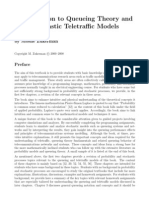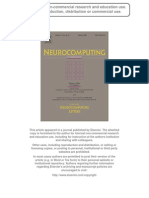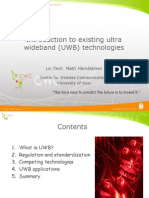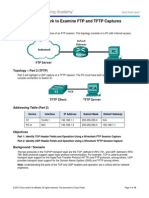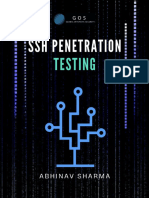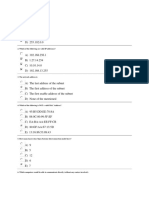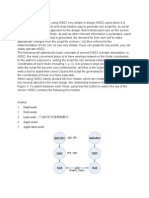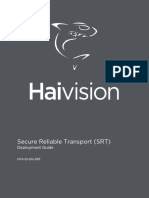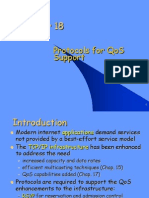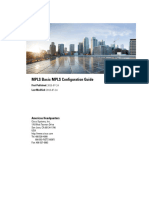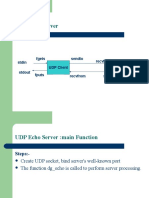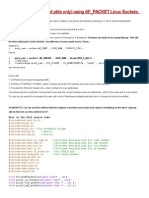2.
Network Traffic & Flow
Analysis
Data Link Layer
Ethernet 802.3
ARP Attacks & Detection
The so-called gratuitous ARP requests and responses are also possible, and
they are usually abused by attackers.
Gratuitous ARP request: Ιt is a request packet where the source and
destination IP are set with the IP of the machine that is issuing the packet
and the destination MAC is the broadcast address.
Gratuitous ARP may be useful to detect IP conflict or simply inform other
hosts/switches of a MAC address in the network, but attackers can also use
these packets to mount ARP poisoning attacks.
2. Network Traffic & Flow Analysis 1
Gratuitous ARP reply: It is an ARP reply that has been sent without being
requested. (usually malicious)
Tips regarding normal and suspicious ARP traffic.
Normal: ARP broadcasts are normal from both clients and servers, including
network devices at a reasonable flow.
Suspicious: Tens, hundreds, or even thousands of ARP broadcast messages
within a small time window
ARP poisoning (between two communication peers into a local
network)
ARP poisoning can be exploited to add fake information between
The following are the steps for a successful attack (ARP Poisoning):
1. M would pretend to be B to A: it will send a gratuitous ARP reply with the pair:
IP_B->MAC_M
2. Network Traffic & Flow Analysis 2
2. M would pretend to be A to B: it will send a gratuitous ARP reply with the pair:
IP_A->MAC_M
Because of the TTL in hosts ARP caches, an attacker would need to send these
packets at intervals lower than the timeout (usually every 30 seconds is a good
choice).
Once the gratuitous ARP packet is sent, B’s ARP cache gets poisoned with the
entry: IP_A->MAC_M . Next time B wants to send a packet to A, it will be
forwarded to M. (The same thing happens against A.)
Another gratuitous ARP with correct values would restore the correct values
after the sniffing is completed
ARP poisoning (between local host and remote host )
When a host in a LAN wants to send packets to hosts outside the LAN, it uses
the default gateway.
The default gateway MAC address must be used to forward the packet along
with the correct IP address configured by the administrator or given by DHCP.
The use of ARP poisoning in this scenario leads to a MITM attack from local to
remote.
2. Network Traffic & Flow Analysis 3
The following describes the steps that take place in the previous scenario:
1. Host A wants to send packets to the Internet. It already has the IP of the
gateway (IP_G), and it needs the associated MAC address.
2. M can use a gratuitous ARP reply to advertise itself as the default gateway:
binds IP_G with his own (MAC_M).
3. All the traffic meant to leave the LAN will pass through M(the attacker), which
will then redirect it to the real gateway.
ARP Spoofing Prevention
1. Using Static ARP
not a feasible approach into large and always-changing networks
2. Tools like arpwatch can detect but not stop such attacks
3. Switches usually feature protections against ARP spoofing (Port Security)
2. Network Traffic & Flow Analysis 4
MAC Flooding
switches store the MAC address to physical switch port pairing in their Content
Addressable Memory (CAM) table.
<MAC address - port number - TTL>.
MAC flooding is meant to fill the CAM table of the switch.
When the space in the CAM is filled with fake MAC addresses, the switch
cannot learn new MAC addresses so it to forces switches to behave like a hub
and then forward frames on all the ports.
MAC Flooding Prevention
port security (restrict the association of a port with a single source MAC
address)
Additionally, there are switches that can be configured in such a way so that
acting like a hub is prohibited.
802.11 Wireless (layer 2) header
The types of 802.11 packets are:
Management: Connectivity between hosts at layer 2 is based upon those
packets.
Authentication packets
2. Network Traffic & Flow Analysis 5
Association packets
Beacon packets
Control: Delivery of packets is enabled by those packets. Congestion is also
“regulated” by them.
Request-to-send packets
Clear-to-send packets
Data: Those packets are the actual data containers. They are the only packet
kind that can be passed from the wireless to the wired network.
Beacon packets are broadcasted from a wireless access point to inform other
listening wireless clients of its existence and its connection requirements.
IP Layer Attacks with each header
IDS/Firewall Evasion (invalid IP version)
Oftentimes, attackers check the reactions of firewalls and IDS by crafting and
sending datagrams with an invalid IP version
2. Network Traffic & Flow Analysis 6
Stealthy Nmap Scan (changing the IPv4 Protocol Number.)
https://www.iana.org/assignments/protocol-numbers/protocol-numbers.xhtml
The venerable Nmap network scanner leverages this to perform IP protocol
scanning against a given target.
This type of scanning is also a stealthier way to identify a live host.
2. Network Traffic & Flow Analysis 7
Source & Destination IP Addresses
There are three golden detection rules that are related to this set of IPv4 header
fields.
1. Incoming traffic to your network should obviously have a Source IP Address
that doesn’t belong to your network address space. If it does, it is most
probably crafted.
2. Outgoing traffic from your network should obviously have a Source IP
Address that belongs to your network address space. If it doesn’t, there is
most probably a misconfiguration or the address is spoofed.
3. Private network addresses or the loopback mode address also require your
attention
Fragmentation (abused for IDS/IPS evasion purposes)
Fragmentation is the action of dividing a packet whose size is greater than the
Maximum Transmission Unit (MTU)
it can be performed by a router or the sending host itself.
Each fragment’s IP header contains fields and values that facilitate
reassembling the original packet at the destination.
When it comes to fragmented packets, IDS/IPS must act just if they were the
destination host, in terms of packet reassembling. This is for obvious
reasons, IDS/IPS need the whole packet in order to inspect it
2. Network Traffic & Flow Analysis 8
attackers can introduce difficulties in the reassembling procedure by the
IDS/IPS, such as:
Crafted fragmented packets with identical offsets but different payloads
Crafted packets arriving with a great time difference
For the IDS/IPS to safely perform such packet reassembling and inspection, it
should act just like the destination host does. (wait as long as the destination
does for a fragment to arrive)
IP packet exceeding the 65535 bytes limit of data via a ping command (ping-of-
death)
IPv6
IPv6 Tunneling
It is a known fact that attackers have been using tunnelbased IPv6 transition
mechanisms for hide communication and stealthy exfiltration over an IPv4-only
or dual-stack network.
2. Network Traffic & Flow Analysis 9
Network Discovery Attacks
Attackers ultimately want to introduce incorrect IPv6 host address/link
layer pairings; this can be achieved via two (2) distinct ways:
1. An attacker on the same local network can tamper with a returned Neighbor
Advertisement (NA) spoofing an address, after a Neighbor Solicitation
(NS) request is sent; this is the equivalent of ARP poisoning in IPv4.
2. An attacker can also craft an NS request containing the fake IPv6 host
address/link layer pairing. Listening neighbors will introduce this not
requested pairing in their neighbor cache; this is the equivalent of abused
Gratuitous ARP in IPv4.
Other Network Discovery attacks include:
Causing a DoS, by spoofing an NA response, informing the NS request sender
that the target host resides at a non-existing link address. The same can be
2. Network Traffic & Flow Analysis 10
achieved by abusing the Neighbor Unreachable Protocol to sent a spoofed NA
response informing that communication with the target is not possible.
Causing a DoS, by spoofing an NS response, informing that the address is
taken. Recall the Duplicate Address Detection procedure. DAD could be abused
multiple times to prevent a host from being assigned an address.
Executing a man-in-the-middle attack, by spoofing an RA, informing the host
that sent the RS message that the attacker’s host is the router.
Those, are only a subset of the attacks that can be executed against an IPv6
implementation. For more, please refer to the following resources:
1. https://www.ripe.net/support/training/material/ipv6-
security/ipv6security-slides.pdf
2. https://www.blackhat.com/docs/sp-14/materials/arsenal/sp-14-
Schaefer-Workshop-Slides.pdf
3. https://www.tno.nl/media/3274/testing_the_security_of_ipv6_imple
mentations.pdf
Transport Layer Attacks
TCP - UDP Theoretical
Transport layer (segments/datagrams)
the transport layer is the link between the application layer and the lower layers
that are responsible for network transmission.
Transport Layer Responsibilities:
1. Tracking Individual Conversations
2. Segmenting Data and Reassembling Segments
3. Add Header Information
4. Identifying the Applications
5. Conversation Multiplexing
a. the transport layer uses segmentation and multiplexing to enable
different communication conversations to be interleaved on the same
network.
2. Network Traffic & Flow Analysis 11
the benefits of dividing the data into segments :
Increases speed - Because a large data stream is segmented into packets,
large amounts of data can be sent over the network without tying up a
communications link. This allows many different conversations to be
interleaved on the network called multiplexing.
Increases efficiency - If a single segment fails to reach its destination due to
a failure in the network or network congestion, only that segment needs to be
retransmitted instead of resending the entire data stream.
TCP is responsible for sequencing the individual segments.
TCP & UDP
TCP
- Transmission Control Protocol. Enables reliable communication between
processes running on separate hosts and provides reliable, acknowledged
transmissions that confirm successful delivery. (segments) (Connection-
Oriented=must first establish a connection between the sender and the receiver)
TCP provides reliability and flow control using these basic operations:
Number and track data segments transmitted to a specific host from a
specific application
Acknowledge received data
Retransmit any unacknowledged data after a certain amount of time
Sequence data that might arrive in wrong order
Send data at an efficient rate that is acceptable by the receiver
2. Network Traffic & Flow Analysis 12
The six control bits flags are as follows:
URG - Urgent pointer field significant
ACK - Acknowledgment flag used in connection establishment and session
termination
PSH - Push function
RST - Reset the connection when an error or timeout occurs
SYN - Synchronize sequence numbers used in connection establishment
FIN - No more data from sender and used in session termination
TCP Server Processes
Each application process running on a server is configured to use a port
number.
The port number is either automatically assigned or configured manually by a
system administrator.
An individual server cannot have two services assigned to the same port
number within the same transport layer services.
2. Network Traffic & Flow Analysis 13
There can be many ports open simultaneously on a server, one for each
active server application.
TCP Connection Establishment (3-way Handshake)
It establishes that the destination device is present on the network.
It verifies that the destination device has an active service and is accepting
requests on the destination port number that the initiating client intends to
use.
It informs the destination device that the source client intends to establish a
communication session on that port number.
Session Termination ( 4-way Handshake)
2. Network Traffic & Flow Analysis 14
TCP Reliability – Sequence Numbers and Acknowledgements
TCP Retransmission
TCP Flow Control - Window Size (Watch)
2. Network Traffic & Flow Analysis 15
MSS= Maximum Segment Size
TCP Congestion Control
2. Network Traffic & Flow Analysis 16
UDP
- User Datagram Protocol. Enables a process running on one host to send
packets to a process running on another host. However, UDP does not confirm
successful datagram transmission. (datagram) (Connectionless)
UDP does not provide reliability or flow control
it does not require an established connection
UDP is also known as a best-effort delivery protocol because there is no
acknowledgment
Live video and voice applications can tolerate some data loss with minimal or
no noticeable effect, and are perfectly suited to UDP.
2. Network Traffic & Flow Analysis 17
Socket:
The combination of the source IP address and source port number, or the
destination IP address and destination port number is known as a socket.
The socket is used to identify the server and service being requested by the
client
The socket on a web server might be 192.168.1.7:80
these two sockets combine to form a socket pair: 192.168.1.5:1099,
192.168.1.7:80
Sockets enable multiple processes, running on a client, to distinguish
themselves from each other, and multiple connections to a server
process to be distinguished from each other.
Suspicious TCP Traffic
1. Excessive SYN packets (scanning)
2. Usage of different flags
3. Single host to multiple ports or single host to multiple nodes (scanning)
4. Source Port Abnormalities :
Privileged (server) ports [1-1023] ← Should remain unchanged during the
entire connection
Unprivileged (client)/ephemeral ports [1023-65535] ← Chosen only for
one connection. Can be chosen again after the connection closes.
2. Network Traffic & Flow Analysis 18
If you carefully look at packets , you will notice that the host 192.168.1.6
uses the same source port (36901) for multiple connection attempts to
different ports of the remote host. This is abnormal.
5. Sequence Number Prediction & SYN Scanning
One of the ways using which the venerable Nmap tool tries to perform OS
fingerprinting, is by examining the Initial Sequence Numbers (ISNs)
generated by the target host (after connections are being attempted to a
listening port).
Each TCP/IP stack (and subsequently each OS) features its own way of
generating Initial Sequence Numbers.
Nmap repeatedly used the ISN from the scanning host, while scanning the
different ports of the remote host.
Unique ISNs should be used, when attempting to connect to different
ports of a remote host.
2. Network Traffic & Flow Analysis 19
5. Destination Port Abnormalities
when sending a SYN request to Port 0 if the host responds with RST, ACK then
it’s alive
if not it will not respond
6. TCP RST Attack
an existing TCP connection can be cut apart through a crafted TCP RST packet
sent either to the client or the server.
For a successful RST attack to be executed, an attacker should have prior
knowledge of the below.
Source & Destination Ports
2. Network Traffic & Flow Analysis 20
Source & Destination IP
“correct” Sequence Number
the attacker spoofed the src ip and sent a TCP RST packet to the server ti
cut the connection.
7. TCP Session Hijacking
TCP is defenseless against “packet injection” attacks.
An attacker could choose to hijack a whole TCP session, instead of executing
a simple TCP RST attack. (requires the same prior knowledge as the TCP RST
attack.)
Telnet offers no encryption and thus, we can see every command the client
issued and every result returned by the server in clear text.
Let’s analyze packet #15.
TCP Retransmission is displayed because the sequence number and the
acknowledgement number of this packet are the same as the ones in packet
#11.
2. Network Traffic & Flow Analysis 21
The MAC address of the client (192.168.1.4) in packet #15 (attacker) is
different than the MAC address that is included in all previous packets
related to this host.
It looks like an attacker has taken over (hijacked) the whole Telnet session.
This is also apparent in packet #17, that includes the MAC address of the
attacker and the
command the attacker issued (uname –a)
The server has no defense mechanism to detect that the Telnet session is
hijacked and sends the output of the uname –a command back to the
192.168.1.4 client.
8. TCP Timestamps Option
the TCP Timestamps options can be abused in
order to:
1. Determine the patch level of a system, through uptime analysis
2. Perform host identification using clock skew
3. Identify how a target DMZ is structured
https://www.scip.ch/en/?labs.20150305
9. Leveraging TCP Option Support & Ordering
TCP/IP stacks, support a subset of the available TCP options and also, perform
TCP option storing in their own unique order. Nmap leverages the above (and
other things), in order to perform OS fingerprinting.
https://nmap.org/nmap-fingerprinting-article.txt
UDP-based attacks
DNS Command & Control, DNS exfiltration (to be disscused)
ICMP Abuse
1. ICMP Echo Request (8)
2. Network Traffic & Flow Analysis 22
To map live hosts
most sites nowadays disallow inbound and/or outbound ICMP echo
requests.
2. ICMP Address Mask Request(17)/Reply(18)
can be used to identify a target host’s subnet mask.
3. ICMP Timestamp Request(13)/Reply (14)
can be used to obtain timestamps from remote systems.
used in zero days attack to see if the system got patched
4. Smurf Attack(DDoS)
is executed as follows:
1. the attacker sends fake echo requests to an intermediate ip broadcast
network with a spoofed src ip of the target
2. the requests is transmitted to all of the network hosts on the network
3. all hosts on the network will send an ICMP echo reply to the target server
causing it to get down
5. ICMP Tunneling
ICMP can be misused to create a covert channel of communication. This can
be achieved through ill-intended ICMP tunneling
Numerous ICMP tunneling solutions exists, but attackers seem to prefer the
ptunnel one.
2. Network Traffic & Flow Analysis 23
Detection
You can see two or more replies for each request
An Echo request and the associated Echo reply should have the same length.
This isn’t the case in this capture file
The payload size in some ICMP packets is a lot bigger than normal. see
packet #16.
all ICMP packets of this capture file include the previously mentioned ptunnel
magic value (0xD5200880), inside the ICMP payload.
we can use strings ptunnel.pcap to identified the strings in the pcap
6. Abusing ICMP Redirect
When two machines want to communicate with each other the router has to find
the shortest path between them.
If there is an alternate shorter path between the two machines then, the router
will send an ICMP redirect packet to the sender machine to change its routing
2. Network Traffic & Flow Analysis 24
table so that it uses the shortest path.
such ICMP redirect packets can be forged by an attacker and make the sender
host redirect its packet to an attacker-controlled or non-existing destination.
A large number of ICMP Redirect packets exist.
In those packets the router instructs the client 10.100.13.126 to make a change
in its routing table to use
the gateway 10.100.13.20 for all subsequent packets. At this moment, you
should check if the gateway 10.100.13.20 is a legitimate gateway.
If you filter the whole capture file, based on the MAC address of the router
(10.100.13.1) [eth.src==72:9b:2f:a0:90:91], you will notice that this MAC address
is associated with the 10.100.13.20 machine.
Even though it is not clearly visible in the capture file, every HTTP request can
now be sniffed by the 10.100.13.20 host, as a result of the ICMP Redirect attack.
Application Layer
Network Basic Input/Output System NetBIOS
a set of protocols developed in for Windows only in order to provide services for
the session layer
NetBIOS provides three services :
1. (NBNS) Name service (works over UDP port 137) for name registration and
name to IP address resolution.
2. Network Traffic & Flow Analysis 25
a. it was later replaced by DNS
2. (NBDS) Datagram distribution service (works over UDP port 138) for service
announcements by clients and servers.
3. (NBSS) Session service (works over TCP port 139) for session negotiation
between hosts. This is used for accessing files, opening directories, and so
on.
There are additional protocols such as Server Message Block (SMB)
SMB
a protocol that is used for browsing directories, copying files, accessing services
such as printers, and several other operations over the network
SMB runs on top of the session layer protocols such as NetBIOS as originally
designed
can also run directly over TCP port 445
Common Internet File System (CIFS) is a form, or flavor, of SMB.
Detection
SMB works in a client-server model
Code 0 means STATUS_OK, which implies that everything works fine and there
is no problem. Any other code should be examined.
NULL session : anonymous and passwordless authentication, if allowed it
could be used to execute various RPC calls and subsequently perform
information gathering or user enumeration.
2. Network Traffic & Flow Analysis 26
MSRPC
RPC (Remote Procedure Call) mechanism allows an application to seamlessly
invoke remote procedures, as if these procedures were executed locally
MSRPC is the Microsoft implementation of the DCE RPC mechanism.
File operations utilize SMB/CIFS, whereas administrative operations,
resource management operations etc. utilize MSRPC.
There are multiple MSRPC implementations:
RPC over SMB
DCOM (RPC directly over TCP/UDP) [TCP/UDP port 135]
2. Network Traffic & Flow Analysis 27
RPC over HTTP or HTTPS [TCP/UDP port 593]
HTTP
HTTP uses methods to perform various operations.
Not all methods will be permitted by web server.
Normal vs Suspicious HTTP Trafic
2. Network Traffic & Flow Analysis 28
Normal HTTP Traffic example:
We are seeing 6 packets (4 relating to TCP and 2 relating to HTTP).
Packets 3-6 is the TCP Handshake. HTTP relies on TCP for reliability.
Packet 7 we notice a HTTP method (GET).
Packet 9 we notice a HTTP response code (200 OK).
port 80 is used
we can see the content of the HTTP Stream with Follow -> Follow TCP Stream
2. Network Traffic & Flow Analysis 29
or Select Statistics -> Conversations Under the TCP tab in Conversations we
can see there are 3 TCP Streams. From here we can select a stream and
choose Follow Stream from bottom right corner.
Malicious HTTP Traffic Example
The attacker is attempting sql injection manually
2. Network Traffic & Flow Analysis 30
By further inspection in packet #20, we see that the User-Agent is Firefox and
the OS is Linux
Strangely, packet #56, and the packet after that, packet #73, don’t seem to
contain any SQL injection queries. Maybe he quit?
taking a closer look we found out that The User-Agent for this HTTP GET
Request is Sqlmap. So the attacker didn’t quit, he escalated.
2. Network Traffic & Flow Analysis 31
HTTPS
HTTPS also establishes a handshake similar to TCP but more complicated.
Below is a brief summary:
Both the client and the server need to agree on the protocol version.
Both the client and the server need to select cryptographic algorithms.
Optionally authenticate to each other.
Use public key encryption techniques to establish secure
communications.
Normal vs Suspicious HTTPS Trafic
2. Network Traffic & Flow Analysis 32
Normal HTTPS Trafic
the Secure Sockets Layer portion of the packet details should not be empty
in Client Hello packet. We see the following:
Content Type = Handshak
Handshake Protocol: Client Hello
Version: TLS 1.2
Cipher Suites (11 suites)
Compression Method (1 method)
2. Network Traffic & Flow Analysis 33
in the server’s response, Server Hello packet
2. Network Traffic & Flow Analysis 34
Here we see the Server Key Exchange which will be followed by the Client
Key Exchange packet. (step #3 in the establishment of an SSL/TLS session)
2. Network Traffic & Flow Analysis 35
This is the last packet and the handshake between the server and client is now
complete.
2. Network Traffic & Flow Analysis 36
The rest of the packets between these two devices will now be encrypted.
The traffic is unreadable, but if this is internal traffic within our corporate
environment, then, it is feasible to decrypt this traffic using the private key from
the internal server.
Malicious HTTPS Traffic Example
we can use this filter ssl.record.content_type == 22 in order to get the SSL/TLS
handshakes
2. Network Traffic & Flow Analysis 37
When it comes to SSL/TLS handshakes, you should remember two things:
Each SSL/TLS handshake is effectively a new connection (consuming
resources)
SSL/TLS handshakes are quite CPU intensive operations (server-side)
The number of new Client Hello messages is abnormal.
it looks like we are dealing with a TLS Renegotiation Attack (DoS attack
against the TLS layer)
SMTP (Simple Mail Transfer Protocol)
How SMTP works ?
It's the protocol responsible for sending emails
SMTP is a text-based protocol, meaning that it relies on exchanging ASCII
based strings as commands between the server and the client.
2. Network Traffic & Flow Analysis 38
The SMTP server starts the conversation, once the TCP three-way handshake
is completed, by sending its banner, containing the server’s name and version.
Malicious SMTP Traffic Example
The lack of proper security configuration may also allow the attacker to connect
to the SMTP
server and manually enumerate the users on that server using the VRFY,
EXPN or RCPT TO commands.
User enumeration may be used as part of a social engineering attack or as a
first step of a brute force attack against account passwords on that server.
DNS (Domain Name System)
resolves names to IP addresses.
DNS is a query-response protocol.
DNS traffic normally uses UDP on port 53.
DNS traffic should go to DNS servers only.
Normal vs Malicious DNS Traffic
2. Network Traffic & Flow Analysis 39
Normal DNS Traffic
4 packets: 2 packets for DNS Queries and 2 for DNS Responses.
this is a UDP packet and it’s using an expected port, 53.
2. Network Traffic & Flow Analysis 40
This is the DNS Response to the DNS Query in packet looks normal
Malicious DNS Traffic
DNS Zone Transfers : a way to replicate DNS databases across a group of
DNS servers.
DNS tunnels
2. Network Traffic & Flow Analysis 41

































